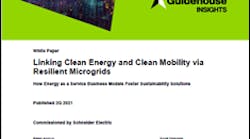Linking Clean Energy and Clean Mobility via Resilient Microgrids
As electric vehicle (EV) adoption grows, it’s straining grid management and retail structures that were not designed to either handle the demand from EV chargers or take advantage of the value EVs can provide the grid. Resilient microgrids and energy as a service (EaaS) business models can help to support grid assets by linking renewables, EVs and advanced software systems to provide real-time optimization of diverse energy sources.
A new white paper from Schneider Electric explores the evolving US electric vehicle landscape, including some adoption barriers the market is facing. It also looks at some of the key drivers for integrating EVs and microgrids, including the declining reliability of the US grid.
The paper builds the business case for electric vehicle fleets and microgrids, and provides a case study on Maryland’s Brookville bus fleet microgrid. Maryland has set the goal of electrifying half of its bus fleet by 2030 and the case study shows how one county is overcoming fleet electrification and microgrid barriers at the same time. The paper concludes with seven policies that states can implement to encourage the link between clean mobility and clean energy microgrids.
